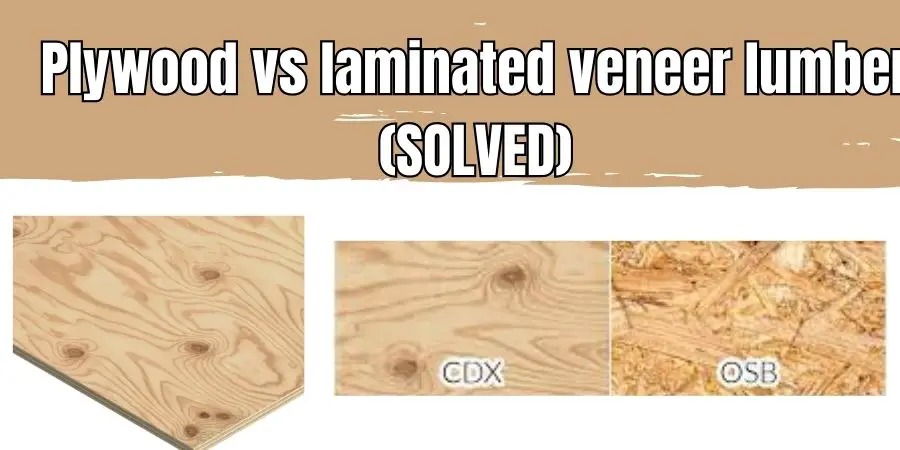Although both materials look the same there are differences between them when it comes to their applications. Let’s find out in this blog post. When it comes to choosing material for your project, there are a few things to consider.
Table of Contents
Plywood vs Laminated veneer lumber
Plywood is great for projects that don’t require a lot of precision or strength, like cabinets or simple furniture. Laminated veneer lumber, on the other hand, is perfect for projects that need more stability and strength. There are a few reasons why plywood might not be the best option for your project:
- Plywood is not as sturdy as laminated veneer lumber. If you’re building something that will need to withstand a lot of stress, plywood might not be the best choice.
- Plywood is less expensive than laminated veneer lumber, but it won’t last as long. Laminated veneer lumber is made with multiple layers of wood that are glued together and then sealed. This makes the wood stronger and more resistant to water damage. Plywood, on the other hand, is made with one sheet of wood that’s usually just glued together. This means that it can’t handle as much pressure and can potentially warp over time.
Laminated veneer Lumber
The advantages of LVL over solid wood include its uniform structure, its high strength, its good dimensional stability, etc., making this product suitable for various applications, including wood-structured buildings, bridges, furniture, and areas of transportation. In fact, Laminate Veneer lumbers are cheaper alternatives to wood, mainly to be used in industrial buildings.
Plywood
Plywood is one of the most commonly used materials for interior projects. Such as making kitchen cabinets, doors, tables, and other decorative items. They are basically cheaper alternatives to woods. Their upper surface is wrapped with wood veneers enabling a wood-like hue. The natural, simple and noble look of plywood can create an environment in a living room that reflects people’s affinity and elegance. Read more: wood vs plywood vs laminate veneer
1. Uses
As a cheaper alternative to natural wood, cross-bonding LVL increases stiffness and allows it to be used for load-bearing walls and floors. There are, however, some factories that produce LVL that has low strength (for instance, poplar), which is used in furniture, decoration, and packaging. The LVL is most commonly used as
- Beams
- Trusses
- Planks
- Rafters.
Plywood has many grades. Different types of woods result in different use cases including furniture making to industrial use, similar to LVL wall beams. However, plywoods are more common in buildings.
- General wood projects. Houses for dogs and rabbits.
- Kitchen cabinets, flooring, and drawers.
- Furniture, including hairdressing table, beds, wardrobe, etc.
3. Structural
There are a few differences between plywood and laminated veneer lumber in terms of manufacturing processes. In spite of that, plywood and LVL are both made of wood veneer after hot pressing and gluing, but the direction of the veneer arrangement is different. An LVL’s veneers run along the grain, and the fibers of adjacent layers run parallel to one another. Plywood is arranged in a vertical and horizontal manner, and wood fibers of adjacent layers are oriented vertically. You can visit this blog to understand the difference between their structure. https://extension.okstate.edu/fact-sheets/laminated-veneer-lumber-lvl-as-a-construction-material.html
4. Appearance
The appearance is different. Similar to their applications, plywoods come wrapped with a beautiful veneer on the surface while LVL does not. The surface of the plywood and the bottom of the plywood are generally covered with thin veneers such as Okoume, Bintangor or Red Oak, or Ash, which are very beautiful and emphasize the decoration of the plywood; LVL laminated veneers are used in building construction and structural elements, as they emphasize strength and deflection, and they do not have high specifications in terms of good-looking appearance.
5. Purpose:
Laminated veneer timber is a product aimed at replacing sawn timber. Focusing on the enhancement of the long-term structural properties to be used in its industrial applications. Emphasizing the anisotropy of wood. A plywood panel is designed as a strong wood substitute that is less expensive than natural wood to make furniture.
Is LVL better?
Not only is LVL strong, it can also replace traditional hardwoods due to its strength.
- Here are some of the benefits you can get from LVL.
- The strength of LVL makes it an excellent alternative for walls and beams to steel and hardwoods.
- As opposed to hardwood and steel, you get more options with this material.
- The lightweight design makes handling safer and easier
- With the options, you can choose an LVL board according to your price range.
- Less prone to warping or shrinking, resist insects better than hardwoods since LVL is treated with resins to keep the water and insects away.
Is plywood better?
- Plywood is strong, affordable, and versatile. It can be used for a variety of projects, from furniture to cabinets to walls. Plywood looks great, and it’s a great option for homes that are on a budget.
- Plywood is durable so furniture made of this material lasts long. Less maintenance is required.
- Another advantage of plywood is its moisture resistance. This means that it can resist damage from water, which is great for exterior applications like decks and patios.
- Plywood is lightweight which makes it ideal to handle. Good material for beginners to get started with the project.
- The pliable nature of plywood makes it perfect for curved surfaces.
- There are also ways to treat plywood so that it can be used as a fire-retardant material.





